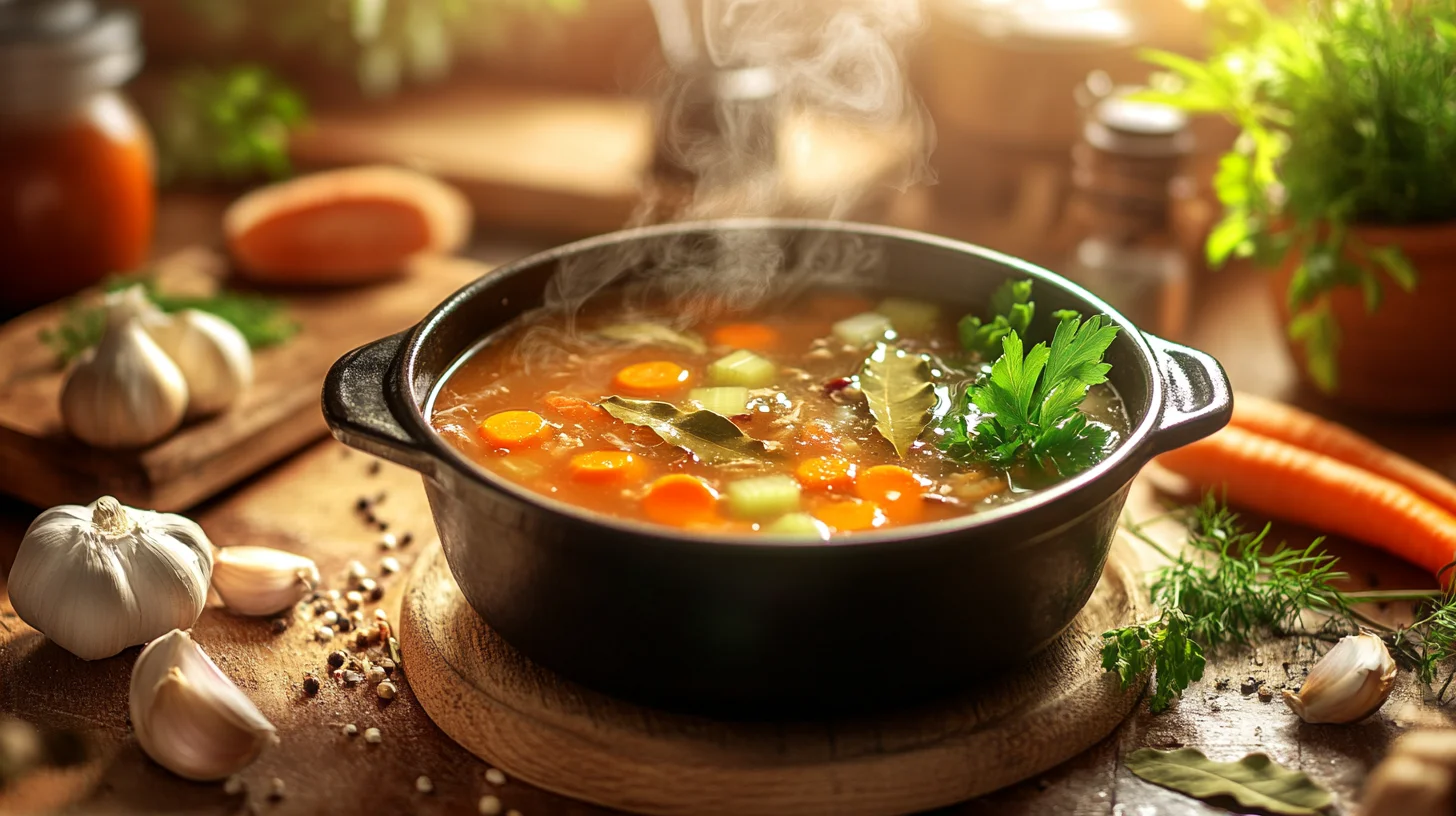
Ultimate Chicken Carcass Stock
Transform leftover chicken carcasses into a deeply flavored, nutrient-packed broth. This recipe maximizes every bit of flavor and goodness from your chicken leftovers while reducing food waste. The resulting stock is versatile, comforting, and a great base for countless dishes.
Equipment
- Large stockpot or slow cooker: For simmering the ingredients.
- Strainer or fine mesh sieve: To remove solids for a clear broth.
- Ladle: For skimming off foam and transferring the stock.
- Cutting board and knife: For chopping vegetables.
- Measuring cups and spoons: To measure water, vinegar, and seasonings.
- Storage containers: Airtight jars or freezer bags for refrigeration/freezing.
Ingredients
- Chicken Carcasses: 1–2 leftover carcasses from a roasted or cooked chicken
- Water: Approximately 10 cups or enough to fully cover the carcasses and vegetables
- Carrots: 2 medium roughly chopped
- Celery Stalks: 2 roughly chopped
- Onion: 1 large quartered (no need to peel)
- Garlic: 3 cloves crushed
- Bay Leaf: 1
- Fresh Herbs: A few sprigs of thyme and parsley or 1 teaspoon dried thyme and 1 teaspoon dried parsley
- Peppercorns: 10 whole
- Apple Cider Vinegar: 1 teaspoon optional, helps extract minerals from the bones
- Salt: To taste start with about ½ teaspoon and adjust later
Instructions
- Prepare the Ingredients:
- Place the chicken carcasses in the large stockpot.
- Add chopped carrots, celery, quartered onion, and crushed garlic.
- Toss in the bay leaf, thyme, parsley, and whole peppercorns.
- Optionally, sprinkle in apple cider vinegar and a pinch of salt.
- Add Water:
- Pour in enough water to cover all the ingredients completely (about 10 cups).
- Bring to a Boil and Simmer:
- Place the pot over high heat until the liquid comes to a rolling boil.
- Reduce the heat to low and let it simmer gently.
- Tip: Skim off any foam or impurities that rise to the surface with a ladle.
- Long Simmer:
- Allow the stock to simmer uncovered for 3 to 4 hours (for a richer flavor, simmer for up to 6–8 hours).
- Check occasionally and add a little water if needed to keep the ingredients submerged.
- Strain the Stock:
- Once the simmering time is complete, remove the larger solids using a slotted spoon.
- Strain the broth through a fine mesh sieve (or cheesecloth for extra clarity) into another pot or large bowl.
- Cool and Store:
- Let the stock cool to room temperature.
- Transfer the cooled stock into airtight containers.
- Refrigerate for up to 5 days or freeze for up to 3 months.
- Details
- Prep Time: 15 minutes
- Cook Time: 3–4 hours (extend up to 6–8 hours for deeper flavor)
- Total Time: Approximately 3.5–4 hours (or longer with extended simmering)
- Yield: About 8–10 cups of stock (varies based on carcass size and water added)
- Category: Stock/Broth, Soup Base
- Method: Slow Simmering
- Cuisine: Homestyle, American Comfort Food
- Diet: Paleo-friendly, Keto-friendly, Gluten-free (assuming no additional gluten ingredients)
- Keywords
- Chicken stock, homemade broth, chicken carcasses, leftover chicken, sustainable cooking, nutrient-dense, comfort food, waste reduction, slow cooking, versatile stock
- Nutrition (per 1 cup serving, approx. 240 ml)
- Note: Nutritional values can vary depending on specific ingredients and fat skimming; these are estimated values.
- Calories: ~40–60 kcal
- Sugar: ~2 g
- Sodium: ~80–150 mg (depending on salt added)
- Fat: ~2–3 g
- Saturated Fat: ~0.5–1 g
- Unsaturated Fat: ~1.5–2 g
- Trans Fat: 0 g
- Carbohydrates: ~4–5 g
- Fiber: ~1 g
- Protein: ~3–5 g
- Cholesterol: ~10–15 mg
Notes
For a Deeper Flavor: Roast the chicken carcasses in the oven at 400°F (200°C) for 20–30 minutes before adding them to the pot.
Clarity Tip: For a clearer stock, strain the liquid twice or use a layer of cheesecloth.
Flexibility: Feel free to add other vegetables (like leeks or parsnips) or herbs based on what you have on hand—the recipe is very forgiving.
Storage Tip: Once refrigerated, any fat that solidifies on top can be removed for a leaner stock.
Usage Ideas: Use this stock as a base for soups, stews, risottos, or sauces. It’s also great for cooking grains or as a warm, comforting drink.
Enjoy making the absolute most of your chicken carcasses with this wholesome, versatile stock recipe!
Clarity Tip: For a clearer stock, strain the liquid twice or use a layer of cheesecloth.
Flexibility: Feel free to add other vegetables (like leeks or parsnips) or herbs based on what you have on hand—the recipe is very forgiving.
Storage Tip: Once refrigerated, any fat that solidifies on top can be removed for a leaner stock.
Usage Ideas: Use this stock as a base for soups, stews, risottos, or sauces. It’s also great for cooking grains or as a warm, comforting drink.
Enjoy making the absolute most of your chicken carcasses with this wholesome, versatile stock recipe!